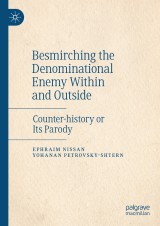Details

Besmirching the Denominational Enemy Within and Outside
Counter-history or Its Parody|
96,29 € |
|
| Verlag: | Palgrave Macmillan |
| Format: | |
| Veröffentl.: | 22.08.2024 |
| ISBN/EAN: | 9783031460692 |
| Sprache: | englisch |
Dieses eBook enthält ein Wasserzeichen.
Beschreibungen
Counter-hagiography and counter-biography besmirch foundational figures held dear by different religious, political, or social groups. Such phenomena figure prominently in the history of religion and conflicts. For example, what we know of the Mazdakite revolution in pre-Islamic Iran/Iraq comes from revilers. The anti-Judaic polemicist from ninth-century Afghanistan and Iraq, <i>Hiwi</i> (“Snake”), was actually called <i>Ḥəyyāwī</i> (still a name among Iraqi Jews). The reputation of the great Haskalah (Jewish Enlightenment) thinker Moses Mendelssohn was damaged among the Orthodox by how Haskalah extremists portrayed him in their image. In 1869, a Genoan politician, Cesare Cabella, fulminated against Esther and Mordecai. In the <i>Letter of Haman</i> in rabbinic homiletics, Jews parodized hostile representations of their sacred history. Gerson Rosenzweig parroted in his 1892 talmudic-style <i>Tractate</i> <i>America,</i> anti-immigrant rhetoric from New York newspapers. Roman-age rabbis responded to claims about the protagonist of the Book of Joshua, “Joshua the Robber” as per a North African inscription early Byzantine Procopius of Caesarea alleged to have seen.
<p>Part I Antiquity to the Middle Ages: An Iranic Locale, Outside Views.- 1. Mazdak, Mazdakism, and the Mazdakite Parenthesis in Sasanian History.- 2. “Ḥiwi” (Ḥəyyawi) of Balkh.- 3. Poor Pharaoh, Wicked Moses: The “Letter of Haman” — A Rabbinic Parody of Anti-Jewish Counter-History.- Part II Modern Contexts: Otherworldly Counter-Biography of the Other and the “Enemy Within”.- 4. Haim Vital, Founders of Other Faiths, and the Censors Nicholas I.- 5. Moses Mendelssohn, Hartwig Wessely, and Fear of the Haskalah.</p>
<p><strong>Ephraim Nissan</strong> is a scholar with over 600 publications. Apart from his multidecade record as book series or journal editor, he has guest-edited thematic issues for journals more than twenty times, most recently a volume for the centennial of Berthold Laufer's <em>Sino-Iranica</em> on cultural exchanges involving Asia. His humanities research is interdisciplinary and addresses late antique, premodern, and recent cultures, mainly Jewish studies, but also Italian, folklore, humour studies, history of medicine, and more. Several more of his volumes (edited or authored) on the representation (either counter-biographical, or appropriative) of prominent characters across the religious divide are forthcoming with Palgrave.</p>
<p> </p>
<p><strong>Yohanan Petrovsky-Shtern</strong> holds the Crown Family Chair in Jewish Studies at Northwestern University, where he teaches early modern, modern Jewish, and East European history. He has published seven books focusing on the socio-cultural, intellectual, and comparative literary history of Jews in Eastern Europe. His books and articles have appeared in Polish, Russian, Ukrainian, French, Hebrew, Spanish, and German. He has served as a visiting professor in France, Poland, Germany, Israel, and Ukraine.</p>
<p> </p>
<p><strong>Yohanan Petrovsky-Shtern</strong> holds the Crown Family Chair in Jewish Studies at Northwestern University, where he teaches early modern, modern Jewish, and East European history. He has published seven books focusing on the socio-cultural, intellectual, and comparative literary history of Jews in Eastern Europe. His books and articles have appeared in Polish, Russian, Ukrainian, French, Hebrew, Spanish, and German. He has served as a visiting professor in France, Poland, Germany, Israel, and Ukraine.</p>
Counter-hagiography and counter-biography besmirch foundational figures held dear by different religious, political, or social groups. Such phenomena figure prominently in the history of religion and conflicts. For example, what we know of the Mazdakite revolution in pre-Islamic Iran/Iraq comes from revilers. The anti-Judaic polemicist from ninth-century Afghanistan and Iraq, <i>Hiwi</i> (“Snake”), was actually called <i>Ḥəyyāwī</i> (still a name among Iraqi Jews). The reputation of the great Haskalah (Jewish Enlightenment) thinker Moses Mendelssohn was damaged among the Orthodox by how Haskalah extremists portrayed him in their image. In 1869, a Genoan politician, Cesare Cabella, fulminated against Esther and Mordecai. In the <i>Letter of Haman</i> in rabbinic homiletics, Jews parodized hostile representations of their sacred history. Gerson Rosenzweig parroted in his 1892 talmudic-style <i>Tractate</i> <i>America,</i> anti-immigrant rhetoric from New York newspapers. Roman-age rabbis responded to claims about the protagonist of the Book of Joshua, “Joshua the Robber” as per a North African inscription early Byzantine Procopius of Caesarea alleged to have seen.<br>
Collects accounts and studies in the field of counter-hagiography and biography Focuses on hostile representations of popular myths and narratives by rival denominations and movements Address this phenomenon in the contexts of Sassanian history, rabbinic literature, early Islam, the Haskalah, and others
Diese Produkte könnten Sie auch interessieren:

The Last Samurai - Japanische Geschichtsdarstellung im populären Kinofilm

von: Daniel Scherrer

34,99 €















